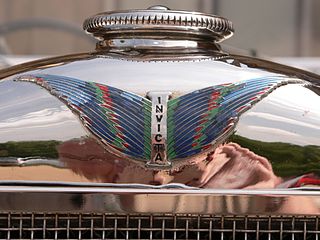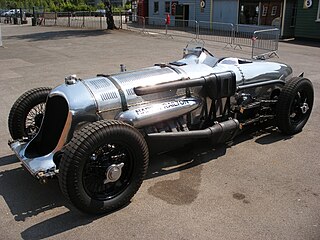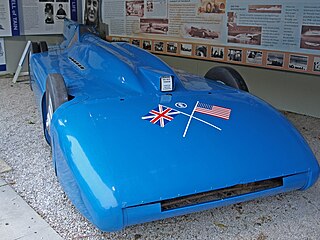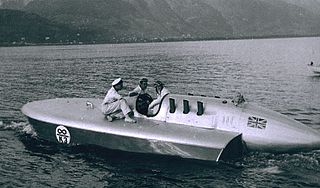
The Arab was a high-performance English automobile designed by Reid Railton and manufactured in Letchworth, Hertfordshire, between 1926 and 1928. The factory had previously been used by the Phoenix car company.

English Racing Automobiles (ERA) was a British racing car manufacturer active from 1933 to 1954.

John Godfrey Parry-Thomas was a Welsh engineer and motor-racing driver who at one time held the land speed record. He was the first driver to be killed in pursuit of the land speed record.

Invicta is a British automobile manufacturer. The brand has been available intermittently through successive decades. Initially, the manufacturer was based in Cobham, Surrey, England, from 1925 to 1933, then in Chelsea, London, England, from 1933 to 1938 and finally in Virginia Water, Surrey, England, from 1946 to 1950. More recently, the name was revived for the Invicta S1 sports car produced between 2004 and 2012.

The Napier-Railton is an aero-engined racing car built in 1933, designed by Reid Railton to a commission by John Cobb, and built by Thomson & Taylor. It was driven by Cobb, mainly at the Brooklands race track where it holds the all-time lap record which was set in 1935. The circuit was appropriated for military purposes during the Second World War, and never reopened in that form for racing. It has a W12 engine with 3 different exhaust systems.

Reid A. Railton (1895–1977) was a British automotive engineer, and designer of land and water speed record vehicles.

The Leyland Eight was a luxury car produced by Leyland Motors from 1920 to 1923.

Captain George Edward Thomas Eyston MC OBE was a British engineer, inventor, and racing driver best known for breaking the land speed record three times between 1937 and 1939.

The Napier-Campbell Blue Bird was a land speed record car driven by Malcolm Campbell. Its designer was C. Amherst Villiers and Campbell's regular mechanic Leo Villa supervised its construction.

The Campbell-Napier-Railton Blue Bird was a land speed record car driven by Malcolm Campbell.

The Campbell-Railton Blue Bird was Sir Malcolm Campbell's final land speed record car.

Speed of the Wind was a record-breaking car of the 1930s, built for and driven by Captain George Eyston.

Blue Bird or Bluebird is the name of various cars and boats used by Sir Malcolm Campbell, his son Donald and other family members to set land and water speed records.
Fred "Skinny" Clemons was an American race car driver and designer. He was one of the first entrants at the Indianapolis 500. He designed and built his own cars, engines and created his own Independent wheel suspension which he patented in 1934. An identification letter 'C’ or ‘Cm ' often appears in front of the race Numbers on Clemons' cars. Lou Meyer, Joe Russo, Wilber Shaw and many other race drivers drove his cars.

Bentley Blower No.1 is a racing car developed from the Bentley 4½ Litre by Sir Henry "Tim" Birkin to win the Le Mans twenty-four-hour race. The car was developed into its current form for racing at Brooklands.

Jarvis & Sons Limited were South London-based motor dealers for Morris and MG, and latterly coachworks providing special bodies for various car chassis until after World War II.

An aero-engined car is an automobile powered by an engine designed for aircraft use. Most such cars have been built for racing, and many have attempted to set world land speed records. While the practice of fitting cars with aircraft engines predates World War I by a few years, it was most popular in the interwar period between the world wars when military-surplus aircraft engines were readily available and used to power numerous high-performance racing cars. Initially powered by piston aircraft engines, a number of post-World War II aero-engined cars have been powered by aviation turbine and jet engines instead. Piston-engined, turbine-engined, and jet-engined cars have all set world land speed records. There have also been some non-racing automotive applications for aircraft engines, including production vehicles such as the Tucker 48 and prototypes such as the Chrysler Turbine Car, Fiat Turbina, and General Motors Firebirds. In the late 20th century and into the 21st century, there has also been a revival of interest in piston-powered aero-engined racing cars.

Sunbeam Works Racing cars participated in the 1922 XVI Grand Prix de l'A.C.F. in Strasbourg. The race took place on 15 July 1922 and was run to a formula stipulating that maximum engine capacity should not exceed 2 litres and that the cars should be two-seaters weighing not less than 650 kg. The formula was to remain in force for four years producing "fields of brilliance to be unequalled for many years" it was the first rolling massed start in the history of Grand Prix motor-racing.

The 1921 S.T.D. 'Works' Grand Prix chassis was built to the three-litre and minimum weight of 800 kilogrammes formula for that year's Indianapolis 500 and French Grand Prix de l’A.C.F. These team cars were modified by the Sunbeam Experimental department in Wolverhampton for the 1922 Isle of Man Tourist Trophy, which was won by one of the cars. A few months later, and with 1916 4.9-litre engines, two of the T.T. cars competed in the Coppa Florio, Sicily and gained second and fourth position.

Jill Scott was a British racing driver and aviator. She was described as "swashbuckling" and was a distinctive figure in motor racing, dressed in cherry-red from head-to-toe whenever she appeared at the race track.



















